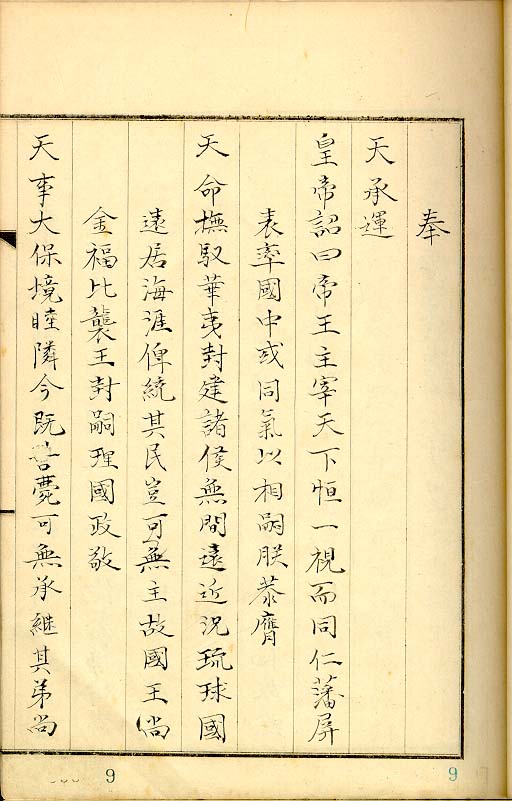nuo tai on:
[Wikipedia]
[Google]
[Amazon]
Tai tou () is a typographical East Asian expression of honor that can be divided into two forms, Nuo tai and Ping tai.
 Shuang tai (, literally ''"double shift"'') as above, but two characters above a normal line. This is used to denote respect for the recipient's parents and other elders. In official texts, this is used when the words emperor (帝) and empress (后) appear.
Shuang tai (, literally ''"double shift"'') as above, but two characters above a normal line. This is used to denote respect for the recipient's parents and other elders. In official texts, this is used when the words emperor (帝) and empress (后) appear.
Nuo tai
Nuo tai (, literally ''"move and shift"'') is atypographical
Typography is the art and technique of arranging type to make written language legible, readable and appealing when displayed. The arrangement of type involves selecting typefaces, point sizes, line lengths, line-spacing ( leading), and ...
device used in written Chinese
Written Chinese () comprises Chinese characters used to represent the Chinese language. Chinese characters do not constitute an alphabet or a compact syllabary. Rather, the writing system is roughly logosyllabic; that is, a character generally r ...
to denote respect for the person being mentioned. It leaves a full-width (1 character wide) space before the first character of the person; it can be represented as Unicode
Unicode, formally The Unicode Standard,The formal version reference is is an information technology standard for the consistent encoding, representation, and handling of text expressed in most of the world's writing systems. The standard, wh ...
character . This is often used in formal writing before using pronouns such as (''guì'', literally ("precious, expensive", or "noble") to show respect. This is also sometimes still used in Taiwan
Taiwan, officially the Republic of China (ROC), is a country in East Asia, at the junction of the East and South China Seas in the northwestern Pacific Ocean, with the People's Republic of China (PRC) to the northwest, Japan to the nort ...
for important officials, such as Chiang Kai-shek and Sun Yat-sen, although this practice has gradually fallen out of favor.
Examples
''(reading left to right)'' *國父 孫中山先生 - Father of the Nation (space) Mr. Sun Yat-sen *先總統 蔣公 - The Late President (space) Honorable Chiang *起初 神創造天地 - '' In the beginning (space) God created the heaven and the earth.'' (In Chinese translations of the Bible, "God" is rendered in competing ways by differentChristians
Christians () are people who follow or adhere to Christianity, a monotheistic Abrahamic religion based on the life and teachings of Jesus Christ. The words '' Christ'' and ''Christian'' derive from the Koine Greek title ''Christós'' (Χρ ...
: as or , which consists of two characters, or as , with only one. In order to avoid a complete re-typesetting of the entire text for this discrepancy, the publishers commonly shifted so that it also took two spaces and the rest of the text could be typeset identically with .)
Ping tai
Ping tai (, literally ''"level shift"'') is another form. The way to express the respect is to shift the name of person directly to the head of the next line. This is now considered old-fashioned, and when it was used it was usually seen in documents sent between emperor and ministers when the minister mentioned the emperor.Dan tai
Dan tai (, literally 'single shift"'') is an archaic form where the shifted phrase is moved to a new line and begins one character above a normal line. Traditionally, this is used when the recipient of the letter is addressed.Shuang tai
 Shuang tai (, literally ''"double shift"'') as above, but two characters above a normal line. This is used to denote respect for the recipient's parents and other elders. In official texts, this is used when the words emperor (帝) and empress (后) appear.
Shuang tai (, literally ''"double shift"'') as above, but two characters above a normal line. This is used to denote respect for the recipient's parents and other elders. In official texts, this is used when the words emperor (帝) and empress (后) appear.
San tai
San tai (, literally ''"triple shift"'') as above, but three characters above a normal line; since Chinese writers customarily leave a margin of two characters for ''tai tou'' from the paper border, a ''san tai'' would require the first character to appear ''outside'' of the page borders. Such a practise is used for characters denoting the divine, such as Heaven, Earth, and deceased ancestors (天, 地 and 祖宗).References